Well, to be honest, this has been one of the most recurring mistakes in all my classrooms. So, I have decided to explain it in this article.
When referring to two people, the correct phrase to use is “She and I.” This is because the subject pronoun “she” is used to refer to the other person, and the pronoun “I” is used to refer to yourself.
For example, if you are talking about going to a movie with your friend, you would say, “She and I are going to the movies.” In this sentence, “she” refers to your friend, and “I” refers to yourself.
On the other hand, using “her and I” would be grammatically incorrect. The pronoun “her” is an object pronoun, which is used to refer to the person who receives the action of the verb. In this case, since “her” is not the subject of the sentence, it is incorrect to use it in conjunction with “I.”
You might also enjoy: Paid Vs Payed : Differences + Examples [My 2024 Teaching Way]
She and I vs Her and I
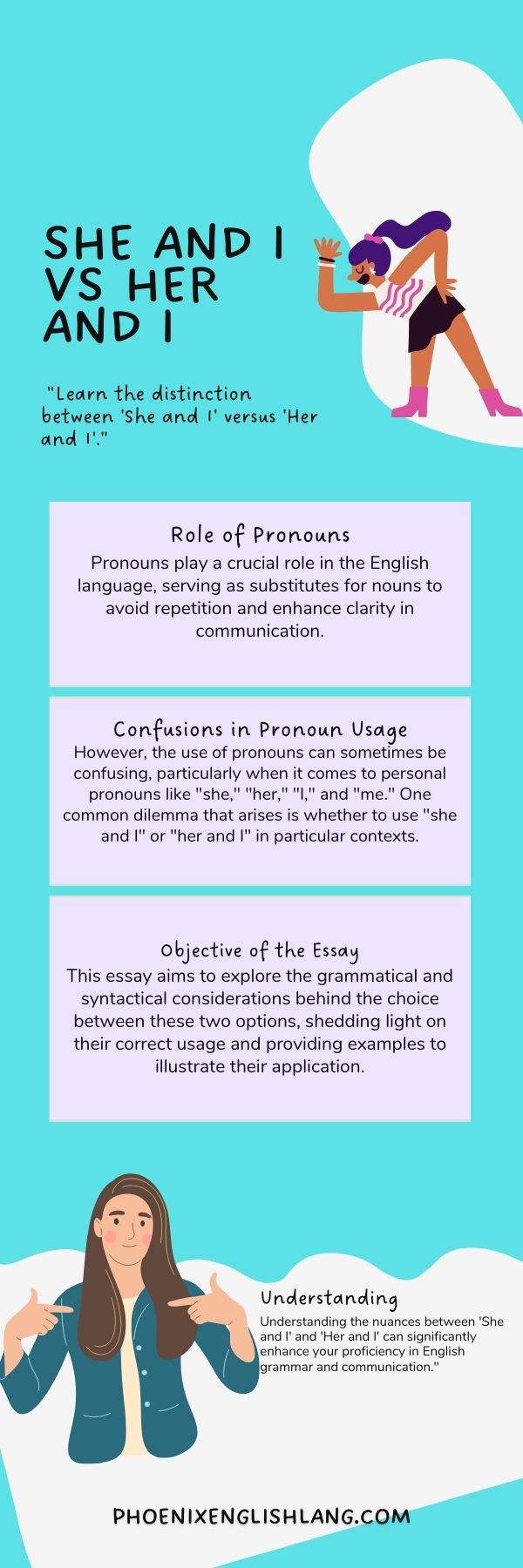
Pronouns play a crucial role in the English language, serving as substitutes for nouns to avoid repetition and enhance clarity in communication.
However, the use of pronouns can sometimes be confusing, particularly when it comes to personal pronouns like “she,” “her,” “I,” and “me.” One common dilemma that arises is whether to use “she and I” or “her and I” in particular contexts.
This essay aims to explore the grammatical and syntactical considerations behind the choice between these two options, shedding light on their correct usage and providing examples to illustrate their application.
You might also enjoy: Has Ran or Has Run: My 2024 + Examples
Understanding Personal Pronouns
Before delving into the specific differences between “she and I” and “her and I,” it is essential to grasp the basic principles of personal pronouns.
Personal pronouns are words used to replace or refer to people, animals, or objects. They can function as subjects, objects, or possessive determiners in a sentence.
In the case of “she and I” and “her and I,” the pronouns “she” and “her” refer to females, while “I” is the first-person singular pronoun.
Subject Pronouns vs Object Pronouns
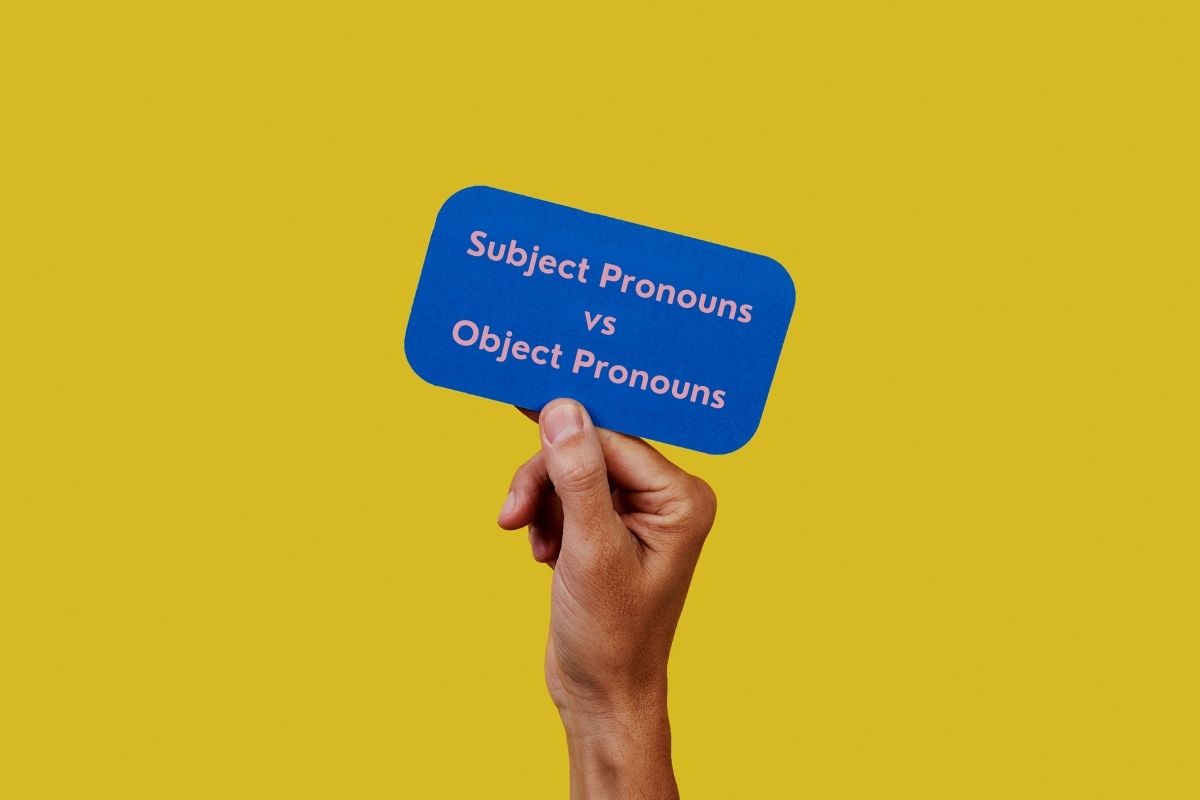
Subject pronouns, including “she” and “I,” are used when the pronoun acts as the subject of a sentence.
On the other hand, object pronouns, such as “her” and “me,” are employed when the pronoun acts as the object of a verb or preposition.
Therefore, the choice between “she and I” and “her and I” depends on whether the pronouns function as subjects or objects in a given sentence.
“She and I” as Subject Pronouns
When “she and I” are the subjects of a sentence or clause, they should be used to convey the action or state of being. For example:
- She and I went to the park.
- She and I are best friends.
- She and I study together every day.
In these examples, “she and I” are the subjects of the sentences, performing the actions of going, being, and studying. Thus, “she and I” is the correct choice as subject pronouns.
“Her and I” as Object Pronouns
Conversely, when “her and I” are the objects of a verb or preposition, they should be used to indicate the recipient or receiver of the action. For example:
- The teacher praised her and me for our hard work.
- He gave the gift to her and me.
- They invited her and me to the party.
In these instances, “her and me” are the objects of the sentences, receiving the praise, gift, and invitation. Therefore, “her and me” is the correct choice as object pronouns.
Now, I’m going to give you some examples. Here are 30 examples with subject pronouns:
- I am going to the store.
- You should study for the exam.
- He is playing basketball.
- She loves to sing.
- It is raining outside.
- We are going on vacation.
- They won the game.
- You and I are friends.
- He and she are siblings.
- It is a beautiful day.
- We love to travel.
- They work together.
- I need some help.
- You are doing a great job.
- He wants to go to the movies.
- She is a talented dancer.
- It’s time to eat dinner.
- We are going to the party.
- They enjoy playing video games.
- You and your brother are invited.
- I am happy to see you.
- He and she are in love.
- It is important to be kind.
- We believe in you.
- They are going on a trip.
- You should take a break.
- I want to learn a new skill.
- He is a hardworking student.
- She enjoys reading books.
- It’s your turn to speak.
You might also enjoy: Performed Vs Preformed: Which One Is Correct? + Examples [2024]
Now, let’s take a look at these examples with object pronouns!
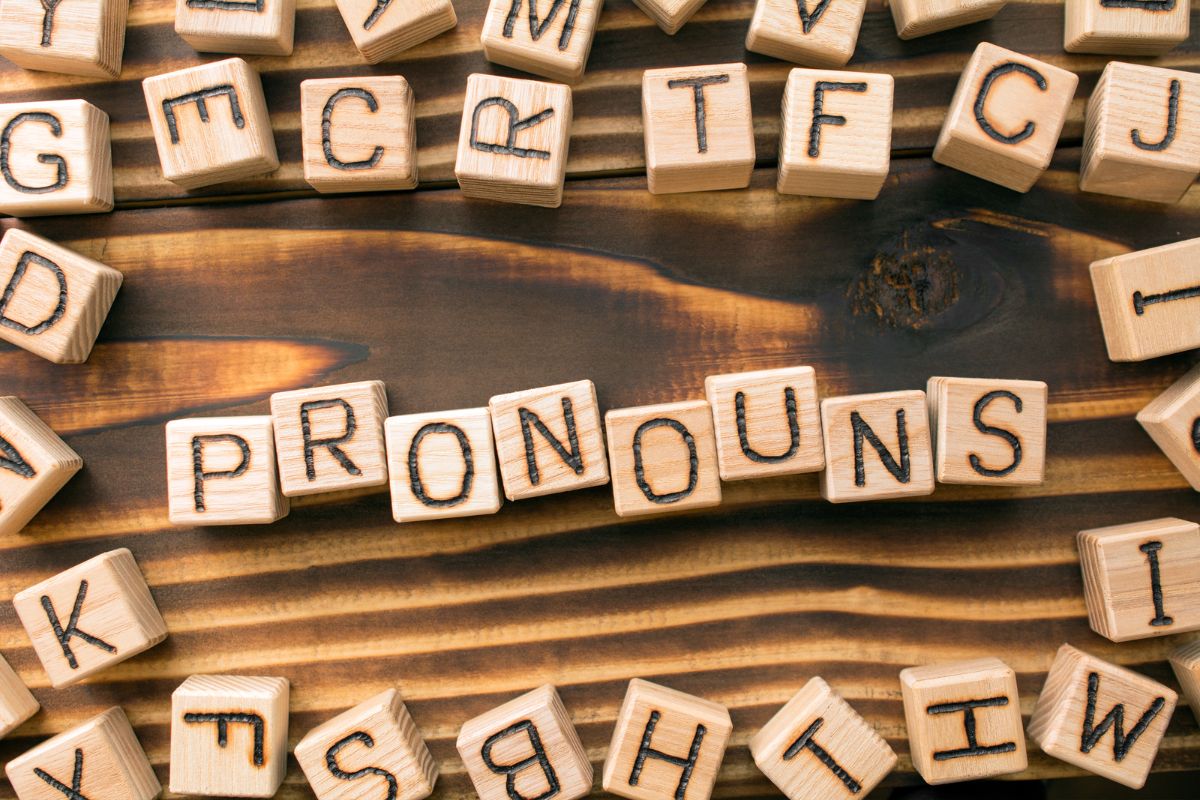
- John called me yesterday.
- Can you help us with the project?
- She invited him to the party.
- I saw her at the mall.
- Please give it to them.
- He told me a secret.
- They bought us some gifts.
- I love you.
- She sent him a letter.
- I baked cookies for her.
- They chose us as the winners.
- He gave it to her as a present.
- Can you lend me your pen?
- She asked him for advice.
- I trust you with my secrets.
- They offered us a job.
- He taught them how to swim.
- She called me by my nickname.
- Can you pass it to them, please?
- I helped her with her homework.
- They supported us during tough times.
- He listened to me attentively.
- She offered him a ride home.
- I sent them a thank-you note.
- He made it for her from scratch.
- She reminded me of the meeting.
- They asked us to join their team.
- He introduced them to his family.
- She hugged me tightly.
- I showed it to her first.
Here is a list of all the pronouns in English
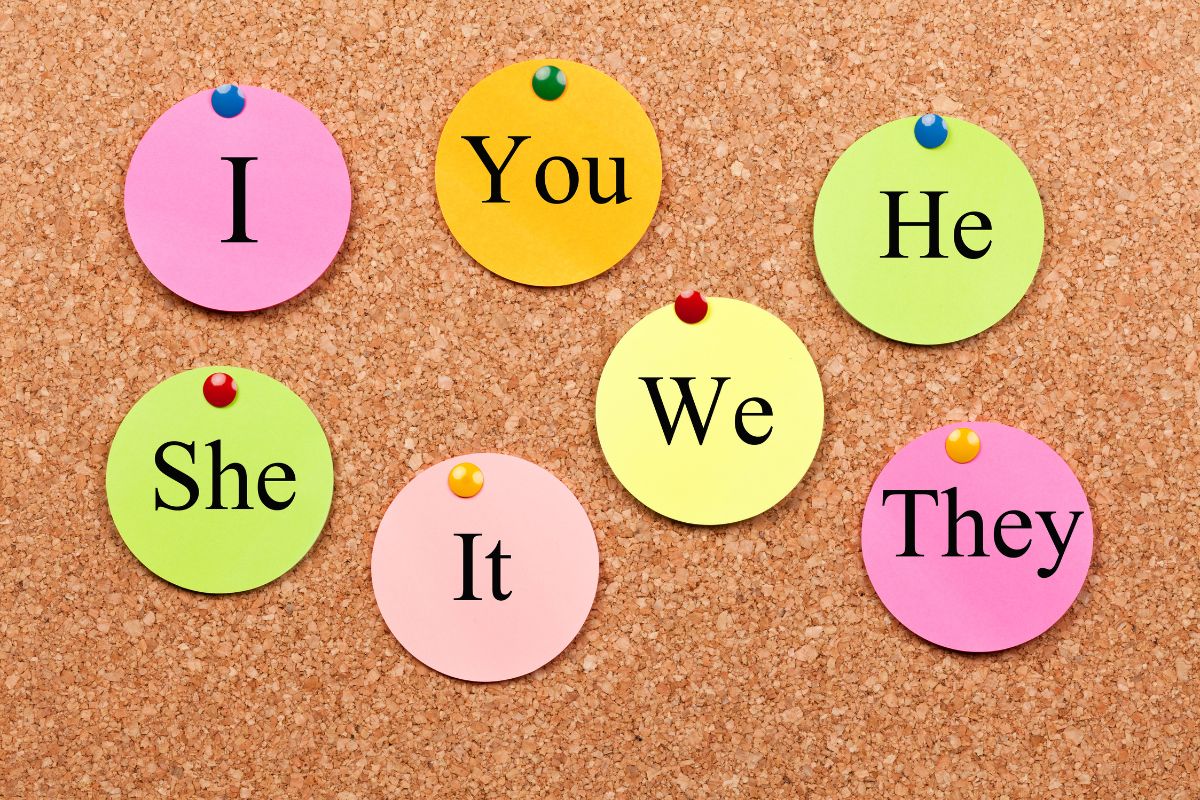
Subject Pronouns
- I
- You
- He
- She
- It
- We
- They
Object Pronouns
- Me
- You
- Him
- Her
- It
- Us
- Them
Possessive Adjective
- My
- Your
- His
- Her
- Its
- Our
- Their
Possessive Pronouns
- Mine
- Yours
- His
- Hers
- Its
- Ours
- Theirs
Reflexive Pronouns
- Myself
- Yourself
- Himself
- Herself
- Itself
- Ourselves
- Yourselves
- Themselves
Demonstrative Pronouns
- This
- That
- These
- Those
Interrogative Pronouns
- Who
- Whom
- Whose
- Which
- What
Relative Pronouns
- Who
- Whom
- Whose
- Which
- That
Indefinite Pronouns
- All
- Another
- Any
- Anybody
- Anyone
- Anything
- Both
- Each
- Either
- Everybody
- Everyone
- Everything
- Few
- Many
- Neither
- Nobody
- None
- Nothing
- One
- Other
- Some
- Somebody
- Someone
- Something
- Several
- All
- Any
- None
- Some
- Such
You might also enjoy: Momma Or Mama – Which One is Correct + Correct Spelling and Grammar
All Types of Pronouns in English
Pronouns are a type of word that are used to replace nouns or noun phrases in a sentence. They help avoid repetitive use of nouns and make communication more efficient. Pronouns can refer to people, things, animals, places, and ideas.
There are several types of pronouns in English. Here are the main categories:
1. Personal Pronouns
These pronouns refer to specific persons or things. They include subject pronouns (I, you, he, she, it, we, they), object pronouns (me, you, him, her, it, us, them), and possessive pronouns (mine, yours, his, hers, its, ours, theirs).
2. Demonstrative Pronouns
These pronouns point to specific persons, things, or ideas. Examples are “this,” “that,” “these,” and “those.”
3. Interrogative Pronouns
These pronouns are used to ask questions. Examples include “who,” “whom,” “whose,” “which,” and “what.”
4. Relative Pronouns
These pronouns introduce relative clauses that provide additional information about a noun or noun phrase. Examples include “who,” “whom,” “whose,” “which,” and “that.”
5. Indefinite Pronouns
These pronouns refer to non-specific persons or things. Examples are “everyone,” “someone,” “anything,” “nothing,” “each,” “both,” “anyone,” “nobody,” and “somebody.”
6. Reflexive Pronouns
These pronouns are used when the subject and object of a sentence are the same. Examples include “myself,” “yourself,” “himself,” “herself,” “itself,” “ourselves,” “yourselves,” and “themselves.”
7. Reciprocal Pronouns
These pronouns indicate a mutual action or relationship between two or more people or things. Examples include “each other” and “one another.”
8. Possessive Pronouns
These pronouns indicate ownership or possession. Examples include “mine,” “yours,” “his,” “hers,” “its,” “ours,” and “theirs.”
You might also enjoy: Openned Or Opened: Spelling + Examples [2024]
Common Mistakes and Misconceptions in Using Pronouns
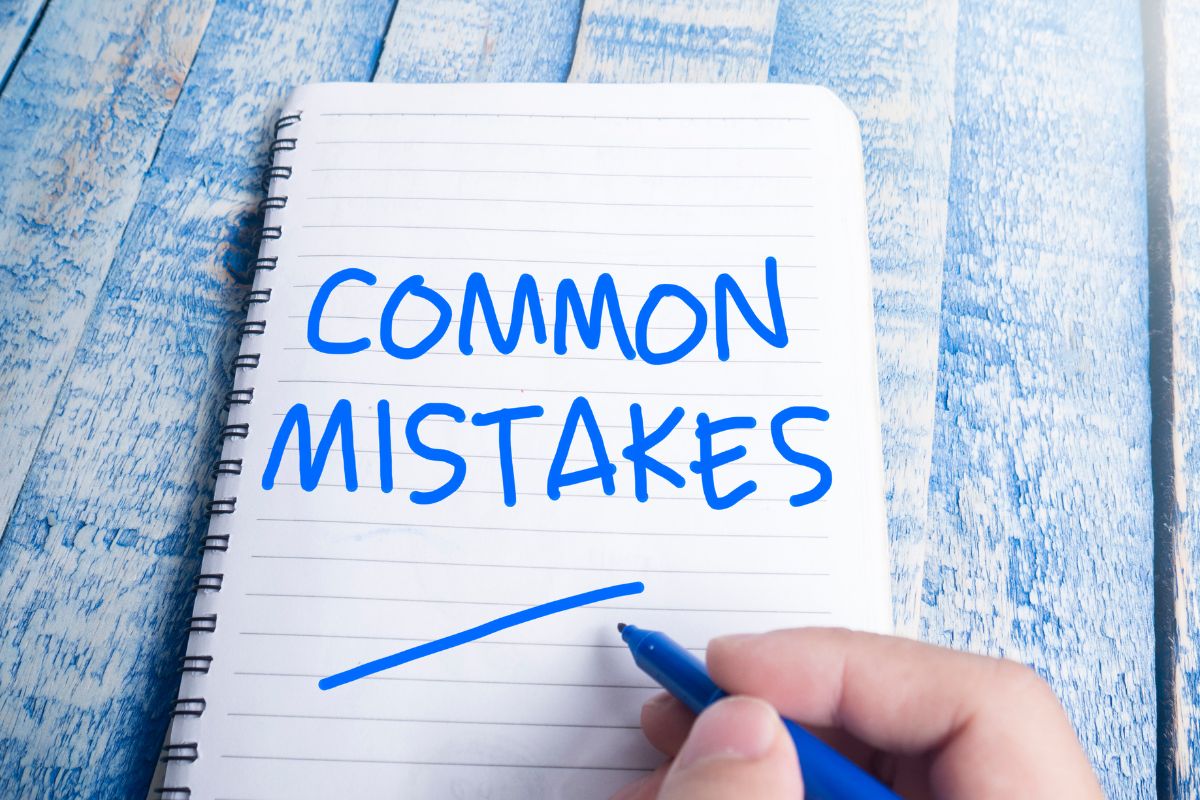
One common mistake made by my students, is the incorrect usage of subject pronouns as objects.
For instance, saying “The teacher praised she and I” or “He gave the gift to she and I” would be grammatically incorrect.
In these cases, “she and I” should be replaced with “her and me” to comply with proper object pronoun usage.
Exceptions and Special Cases
While the general rule is to use “she and I” as subject pronouns and “her and me” as object pronouns, there are exceptions and specific situations where the pronoun choice may vary. For instance:
1. “She and I” can be used as compound subjects in comparisons
– She and I are taller than him.
– She and I are as intelligent as they are.
2. “Her and me” can be used as compound objects in comparisons
– The teacher praised her and me more than others.
You might also enjoy: Cancelled or Canceled; Spelling; Examples [2025]
30 sentences with She and I
- She and I went to the movies last night.
- She and I are planning a trip to Europe.
- She and I love hiking in the mountains.
- She and I enjoy cooking together.
- She and I are both passionate about photography.
- She and I are teammates on the soccer team.
- She and I have been friends since childhood.
- She and I are going to the concert tomorrow.
- She and I share a love for reading.
- She and I are volunteering at the local shelter.
- She and I are studying for our exams.
- She and I often go shopping together.
- She and I have similar tastes in music.
- She and I are part of the same book club.
- She and I are taking a yoga class together.
- She and I are going to the beach this weekend.
- She and I have started a small business together.
- She and I are both avid runners.
- She and I are attending the same university.
- She and I are participating in a charity run.
- She and I are part of a dance group.
- She and I are members of the same choir.
- She and I are roommates in college.
- She and I often go hiking in the nearby forest.
- She and I are planning a surprise party for our friend.
- She and I are working on a research project together.
- She and I are going to a painting class next week.
- She and I are organising a fundraising event.
- She and I are both interested in learning a new language.
- She and I are going on a road trip across the country.
30 questions with She and I
- Can she and I go to the park?
- Does she and I have any plans for the weekend?
- Can she and I borrow your car for a quick errand?
- Have she and I ever traveled together?
- Can she and I join the book club?
- Has she and I ever been to a concert together?
- Can she and I work on this project as a team?
- Does she and I want to try that new restaurant?
- Can she and I take a dance class together?
- Has she and I ever gone hiking before?
- Can she and I attend the party together?
- Does she and I need any help with the move?
- Can she and I meet for coffee tomorrow?
- Has she and I ever been to a museum together?
- Can she and I volunteer at the shelter this weekend?
- Does she and I want to join the gym together?
- Can she and I plan a surprise for our friend’s birthday?
- Has she and I ever cooked a meal together?
- Can she and I study for the exam together?
- Does she and I want to go shopping this weekend?
- Can she and I visit the art gallery on Saturday?
- Has she and I ever attended a theatre performance together?
- Can she and I organise a charity event?
- Does she and I want to go on a road trip?
- Can she and I explore the new hiking trail?
- Has she and I ever attended a sports game together?
- Can she and I work on our fitness goals together?
- Does she and I want to join a language class?
- Can she and I plan a movie night at home?
- Has she and I ever participated in a marathon together?
You might also enjoy: Copys or Copies: Differences + Examples [2024]
My Easy Guidelines for Using Pronouns
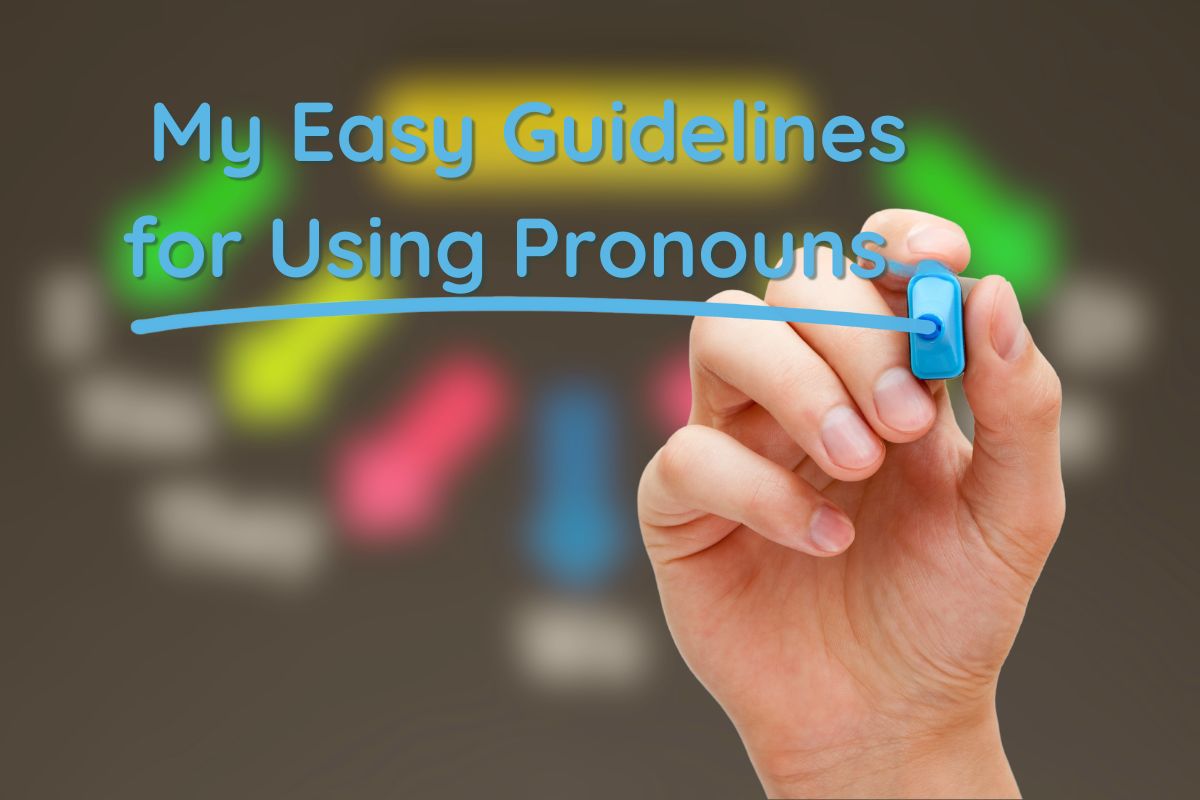
1. Personal Pronouns
– Use subject pronouns (I, you, he, she, it, we, they) when the pronoun is the subject of the sentence.
Example: She is going to the park.
– Use object pronouns (me, you, him, her, it, us, them) when the pronoun is the object of the sentence.
Example: John gave it to me.
– Use possessive pronouns (mine, yours, his, hers, its, ours, theirs) to indicate ownership or possession.
Example: The book is hers.
2. Demonstrative Pronouns
– Use “this” and “these” to refer to something nearby or close in proximity.
Example: This is my car. These are my friends.
– Use “that” and “those” to refer to something distant or far in proximity.
Example: That is his house. Those are their bicycles.
3. Interrogative Pronouns
– Use “who” when referring to a person or people.
Example: Who is coming to the party?
– Use “whom” as an object pronoun when referring to a person or people.
Example: To whom did you give the letter?
– Use “whose” to ask about ownership or possession.
Example: Whose bag is this?
– Use “which” when referring to a thing or things.
Example: Which book do you prefer?
– Use “what” when asking about something in general.
Example: What is your favourite colour?
4. Relative Pronouns
– Use “who” and “whom” to refer to people in relative clauses.
Example: The person who called is my brother.
– Use “which” to refer to things or animals in relative clauses.
Example: The book which I borrowed is interesting.
– Use “that” to refer to people, things, or animals in restrictive relative clauses.
Example: The car that he bought is red.
5. Indefinite Pronouns
– Use indefinite pronouns (everyone, someone, anything, nobody, etc.) to refer to non-specific people or things.
Example: Somebody left their bag here.
6. Reflexive Pronouns
– Use reflexive pronouns (myself, yourself, himself, herself, itself, ourselves, yourselves, themselves) when the subject and object of the sentence are the same.
Example: I hurt myself while jogging.

Hi, welcome to my blog! My name is Omid and I am thrilled to have you here! I am an English language teacher with 12 years of experience and hold multiple international certifications (TESOL, IELTS, TOEFL, PTE, CELTA). Additionally, I hold a PhD in Applied Linguistics with a specialization in Teaching English as a Second Language (TESL), which fuels my passion for teaching English and assisting others in mastering the language. To me, nothing is more rewarding than helping individuals enhance their English language abilities through various methods. So, let’s embark on this journey of learning English together.




